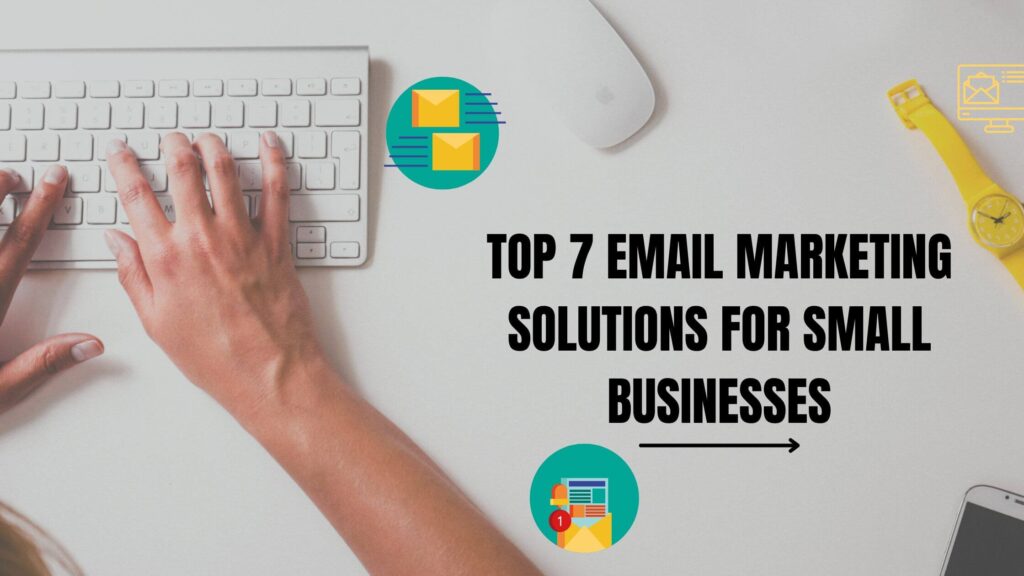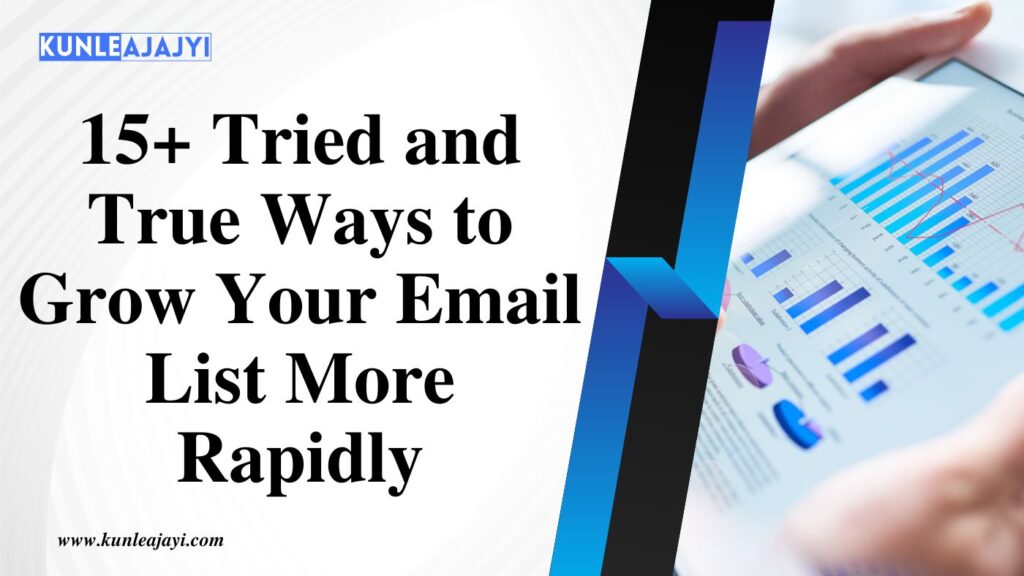Are you considering building an email list, but have some doubts about why it is needed? Many bloggers and business owners don’t realize the importance of building an email list when they’re first starting.
However, most people usually change their minds when they see the impact email lists can have on someone else’s traffic and revenue.
In this post, I will reveal the top reasons why developing an email list is vital (with genuine case studies). I will also show you how to start building your email list – step by step.
In this beginner’s guide, I will cover the following topics:
- What is an email list?
- Why building an email list is important
- Social media vs email marketing
- What marketing experts are saying about email marketing
- What do you need to start building an email list
- How to choose the best email marketing service
- How to grow your email list and get more subscribers
- Finding new list-building strategies and resources
By the end of this article, you should have answers to all your questions about building an email list.
What is an Email List?
An email list is a special list of names and email addresses of people who permitted you to send them updates and promotions from your business.
You can build your email list inside email marketing software and send bulk email notifications to everyone regarding your blog updates, online store, or other business services.
I recommend using Constant Contact or Brevo (formerly Sendinblue) to get started.
Why Building an Email List is Important?
According to the Direct Marketing Association, email marketing on average sees a 4300 percent return on investment (ROI) for businesses in the USA.
Because email subscribers joined your email list from your website and verified their identity by clicking on a link (double-opt-in), they are extremely interested in what you have to offer. This is why they are more likely to convert into paying customers.
In my business, an email list gets 10 times more conversions than social media campaigns.
This makes sense if you think about the reasons that make email an incredibly powerful communication channel:
1. Email is Personal
Email allows you to land in a user’s inbox. There is no ranking system limiting your reach. It is very direct and personal.
2. Email is Purposeful
To get updates from you, a user fills out a form to sign up for your email list and confirm their email address. Someone doing this much work is interested in hearing from you, and they are much more receptive to your message.
3. Email is Targeted
As I discussed previously, the user has already expressed interest in your product or information. Since you already know what they like, you can deliver them highly relevant offers to get better results. This is called segmentation, and I will cover that later in the article.
4. You Own Your Email List
You do not own Facebook, Twitter, or Google. Your social media marketing and SEO efforts can go to waste when these platforms change their regulations. On the other hand, you own your email list, and it is not influenced by the decisions of other businesses.
5. Email is One-on-One
People read emails in the privacy of their inboxes. The message is not on a public timeline or newsfeed. They can ask you questions directly in private with confidence. This helps build trust and connection.
6. More People Use Email Several Times a Day
You may have heard that Facebook has 1.4 billion and Twitter has 100 million daily active users. What you may not have heard, is the amount of people utilizing Email every day.
Every internet user has at least one email account. Recent research conducted by Radicati found that there are 3.8 billion active email accounts. That’s half the population of Earth.
This is precisely why every smart business in the world has an email list.
Big-name businesses learned this lesson a long time ago, and that’s why they spend thousands of dollars on social media ads to persuade people to sign up for their email lists.
They understand that email marketing is the best long-term investment with a much higher return because people will continue to get their message at a very low cost for a longer period.
Social Media vs Email Marketing
Now you’re probably thinking, wait a minute. What about social media?
I have been questioned multiple times isn’t email marketing is kind of dead with social media taking over everything.
The simplest method to respond to this query is to examine the details that Twitter and Facebook need from you before you open an account:
Yup, it’s an email address.
These companies know that emails are the most direct and reliable way of getting in touch with their customers.
Even if you sign up using your phone number, they will keep asking for your email address to help you find friends, password recovery options, and most crucially to send you tailored email messages.
Here is a view of the social tab in a typical Gmail user’s inbox.
All these emails are from huge social media networks, so they can engage you with the information on their platform and get you to visit their app or website again.
All social media sites are growing an email list since they are clever company owners. This enhances their valuation when selling their firm.
While social media is a terrific tool to contact your audience, it’s crucial to keep in perspective the temporal nature of social media platforms.
They move in and out.
Not very long ago I had MySpace, FriendFeed, Google Buzz, Plurk, and countless others. Most of them are either dead now or irrelevant.
Today I have Facebook and Twitter that are prominent, however, not everyone appreciates these platforms. Some people prefer Instagram, Pinterest, WhatsApp, Snapchat, LinkedIn, etc.
Your users are all over the place on different platforms. However, surveys reveal that at least 91% of consumers read their email daily.
I am not suggesting that social media is not vital. It is, and you should investigate every possibility to reach your audience.
However, you should devote more time and effort to something that promises higher results.
What Experts Are Saying About Building an Email List?
Don’t take just my word for it, listen to what all top marketing gurus are saying about email marketing:
Out of all the channels I tested as a marketer, email continuously surpasses most of them.
— Neil Patel – Crazy Egg and QuickSprout
Getting an email address is the first crucial step to figuring out who my reader is, and maybe in the future, my customer of some form.
– Joe Pulizzi – Founder Content Marketing Institute
If you’re not establishing an email list, you’re making a HUGE mistake.
– Derek Halpern – Founder Social Triggers
Email is the most dependable driver of growth and sales in my business. I prefer email marketing over all other traffic channels.
| Syed Balkhi – Founder WPBeginner
Many skilled marketers claim their biggest mistake was not creating an email list when they initially started.
I hope the arguments listed above have persuaded you that all businesses should focus on growing their email lists.
You might now be asking yourself, “How do I build an email list?”
This moves us to the following section.
What You Need to Start Building an Email List?
You are now aware of the significance of creating an email list and the potential pitfalls of ignoring it.
So let’s take a look at everything you need to start creating your email list.
3 Things You Need to Build an Email List:
- A blog or a website.
- A platform for email marketing.
- High-performing sign-up forms
None of these three require programming or design expertise, and they are all rather simple to set up.
I will only be concentrating on the last two items on the list for this post. If you don’t have a website or blog yet, then see my step-by-step guide on how to start a blog or how to make a website.
The Best Email Marketing Service to Use
There are tons of email marketing services out there. It is a sense that beginners would choose the free option to save money. Some of these free platforms, though, aren’t the best. Why?
While offering nothing more than a free blog subscription service via email, some platforms falsely describe themselves as an “email marketing service.” This allows your users to receive an email update every time you publish a new blog post.
But that’s not true email marketing. The following are some drawbacks of utilizing a free blog notification service:
- Private email newsletter distribution is not permitted. Since you must publish a new blog post before sending an email, the details you want to give must first be made available to the general public.
- The message in the email cannot be customized. The delivery will frequently be in the same format without branding or personalization.
- You can’t categorize subscribers by interests, demographics, or content type.
- There is no reporting. You don’t know how many people got the email, what percentage of users opened it, and how many of them clicked on your links.
- If you later try to migrate to a premium service, your users will have to re-confirm their subscription. Many of them won’t, and you’ll lose subscribers as a result.
For this reason, I ALWAYS advise starting by using a reputable email marketing service.
They do cost some money, but they are an investment in your company that will pay off handsomely.
The benefits of professional email marketing services are:
- Your subscribers can get private mass emails from you.
- You can group your subscribers depending on the actions they do and view subscriber activity.
- You can run A/B split tests to see which email subject line, content, and offers work best with your subscribers.
- You can find out which nation has the most subscribers by using reporting tools. You can adjust your time zone preferences, and send emails at the right time.
- You can view all of your subscribers’ email addresses last but most importantly.
Numerous expert email marketing services are readily available. I have written a list of the best email marketing services based on their usability, cost-effectiveness, features, and performance to make it simple for you.
For small businesses, I recommend using Constant Contact or GetResponse because they are one of the largest email marketing firms in the world.
A thirty-day free trial is available. You have plenty of time to set up and begin seeing the consequences as a result. After 30 days, your email list would likely be paying for itself (cost $9 / month).
I advise using HubSpot, Brevo(formerly Sendinblue), or ConvertKit if you’re looking for something more sophisticated with robust marketing automation. They both offer free trials and are incredibly well-liked by business owners.
The next step after signing up for an email marketing provider is to add opt-in forms to your website so that visitors can subscribe.
Increasing Email List and Subscribers
Did you know that more than 70% of website visitors who leave will never come back? It’s true, just look on your Google Analytics and look at the percentage of new vs returning visitors.
That’s why you need to convert every website visitor into an email subscriber before they leave, so you can send them relevant messages to bring them back.
An average internet user spends just a few seconds browsing a webpage. This leaves you with very little time to interact with them. Users will leave your website without ever subscribing if your email sign-up forms are hidden.
I frequently observe newcomers make the biggest error of not properly positioning high-converting opt-in forms.
Even though some WordPress themes provide built-in sidebar widgets, they don’t always convert effectively.
You might also receive codes from your email marketing firm to insert into your theme, but that calls for coding expertise.
This is why I suggest my students use ThriveLead. It is the most potent conversion optimization tool that aids in converting website visitors who are about to leave into subscribers and buyers.
You can simply construct high-converting opt-in forms like lightbox popups, floating header and footer bars, slide-in scroll boxes, fullscreen welcome mats, inline forms, and more rather than adding dull signup forms to your sidebar.
But what makes ThriveLead powerful is the behavior automation and customization tools. ThriveLead allows you to automatically present different opt-in forms based on where the visitor is coming from, which page they are visiting, and what they are doing on your website.
For example, the Exit-Intent® feature tracks your user’s mouse behavior and presents them with a customized opt-in form at the precise moment they are ready to depart. This helps you turn abandoned visitors into subscribers.
Exit intent is used on websites run by influencers like Michael Hyatt, Neil Patel, and Social Media Examiner because of this. Over 95,000 additional subscribers were added to Social Media Examiner in just 7 months as a result.
Small business owner Nicolas Gagne increased the size of his email list by 500% by using Constant Contact in conjunction with a single exit-intent opt-in. He was able to triple his online store’s sales as a result (see the complete case study).
There are loads more case studies and ThriveLead reviews that you may read as well.
List Building Techniques and Materials
Although having the right tools is important, using them correctly is what makes the most difference.
The most crucial aspect of your email marketing strategy to plan is segmentation.
What is segmenting an email list?
Segmenting your email list allows you to better tailor your mailings to each subscriber’s interests.
You benefit from greater open and click-through rates. You may segment your email list like an expert with the help of my comprehensive guide on email marketing.
See my tried-and-true tips for developing your email list more quickly if you want to start expanding it right away.
See this 63-point checklist for designing a high-converting opt-in form if you’re unsure how to create one.
The best opt-in forms to use are content upgrades. It’s a strategy where you include supplemental content at the end of your well-liked blog pieces. These typically convert at a rate of 5 times higher than a typical opt-in. Here are some suggestions for content upgrades that you should look at. I offer a thorough manual on how to use WordPress content upgrades.
In my beginner’s guide to lead generation in WordPress, I go through all the many techniques to collect email addresses in depth.
Conclusion
It makes no difference what kind of company you operate, what kind of website you have, or what sector of the economy you are in.
Get them on your email list if you run a website and want to convert your visitors into repeat clients.
I trust that this post has clarified the value of developing an email list and given you the tools you need to begin going.




